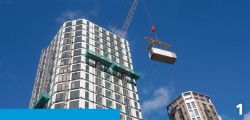Modular construction already has a place in meeting the current housing needs. However, it comes with different fire safety challenges to traditional methods of construction.
Getting it right is vital to its to modular’s acceptance as a mainstream method of providing this muchneeded housing. Fire Safety is key, whether under Approved Document B (ADB), BS 9999 or BS 9991. Detection, alarms and suppression sit alongside passive fire protection and smoke control to give sufficient time for safe evacuation of occupants.
Design
Compartmentation is a fundamental principle in the fire safety of buildings. Fire Compartments contain and prevent the spread of fire. For this to work, walls and structural elements need to maintain their integrity in a fire for a defined period. Attention to detail at manufacturing and installation is key as fire and smoke will get through even small gaps and spaces in walls, ceilings and floors, so getting the fire stopping right is essential. Consideration also needs to be given to in-life and maintenance works such as upgrades, unit replacements, cabling and plumbing alterations.
Design and manufacturing tolerances may need onsite alignment at the assembly stage to ensure the systems will perform as designed and specified. Connection and continuity of all services at the fire boundary therefore needs to be simple and effective to account for such tolerances.
Build
Key challenges exist in ensuring a design can be effectively realised onsite. A firewall needs to be effective from both sides - plumbing, ventilation, and other services including electrical and data services need to be lined up to ensure the fire compartment’s ongoing integrity. Services detailing needs a high level of attention for ‘drop-in-units’ so they align without significant post-installation work. Consideration is also needed for complete replacement of a module, should the future need arise.
Maintain
Ongoing maintenance and ‘in-life replacement’ must be allowed for. As an example, fire dampers, detection and alarm systems all need to be regularly tested to ensure effective operation. Section 38 documentation as well as post-occupation manuals that meet the needs of the RRO, reduces the risk of inadequate and ineffective maintenance. However, maintenance has two challenges: the ability to service the item without compromising the integrity and having sufficient budget to invest and make sure replacement works are carried out to the required standards when needed, including fire-doors.
The future
It is predicted that over 92% of a growing UK population will be living in cities and towns by 2030. This has led to pressure for greater densification and a push towards taller buildings. Research and development has already led to the design and trialing of significantly higher modular construction. A mix of concrete, steel and engineered timber such as cross laminated timber (CLT) has allowed modular designs to already exceed 30 storeys. Work continues with a sustained focus on the detailed design and construction of the individual components in order for these designs to succeed.
Design it right, build it right, maintain it right and you will not only have a fire-safe building but an attractive system of construction that will inevitably have an increasing importance in contributing towards official housing targets and the demands of a growing population.
IFC Group have the experience and expertise to make this happen.
For more information visit:
www.ifcgroup.com
To view this article in Offsite Magazine please visit: Offsite Magazine









